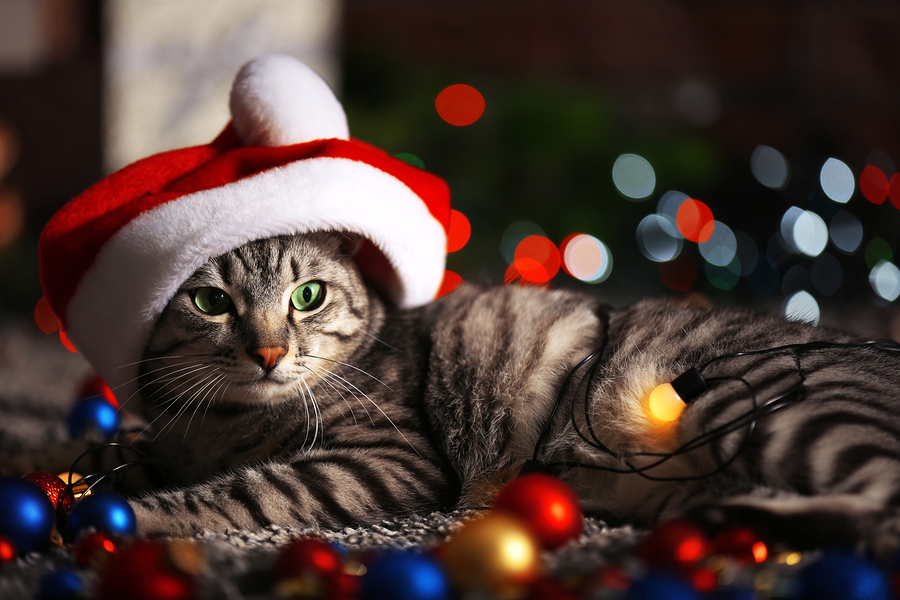Stealing boxes of chocolates. Climbing the tree. Eating the decorations. When it comes to celebrating the holidays at home, many of the things that make the season merry and bright for humans are potential dangers to four-legged family members.
But not all of them are as dangerous as you may think. We take a look at the twinkling and tasty temptations that pets encounter during the holiday season and share which dangers are myths and which are mistakes that could lead to unplanned veterinary visits.
Myth: Poinsettias
Contrary to popular belief, the popular Christmas plants, also known as flame leaf flower, Flower of Christmas Eve, and Crown of the Andes, aren’t deadly to pets.
Poinsettias (Euphorbia pulcherrima) produce a milky white resin that contains chemicals called diterpenoid euphorbol esters and saponin-like detergents. (Saponins are chemicals that have a foamy quality and are used in soaps, as well as other products.) Pets who take just a taste may experience mild irritation. In “more than a nibble” amounts (especially in the case of cats), the resin may irritate the stomach and intestines, causing vomiting, stomach pain, or other intestinal issues, such as diarrhea, but unless the signs are persistent or severe, there’s no call for a veterinary visit.
“Essentially, if you see them nibbling, don’t worry,” says veterinary toxicologist John Tegzes, VMD, professor of toxicology at Western University of Health Sciences in Pomona, California. “But do make sure you take it away from them and reward them when they don’t nibble on them. Or simply place them where pets can’t reach them easily.”
The takeaway: Poinsettias aren’t fragrant or tasty. In most cases, the worst they’ll cause is an upset tummy.
Mistake: Lilies and Mistletoe
Lilies pose much greater risk to cats (less so to dogs) than poinsettias, says veterinary toxicologist Justine Lee, DVM, with the ASPCA Animal Poison Control Center. Christmas, tiger, Asiatic, stargazer, day and Easter lilies are among the most toxic of the lily family.
“As little as two to three leaves or petals, even the pollen, can result in severe, acute kidney failure in cats,” Dr. Lee says. Any part of the lily plant, as well as the water in a vase that holds them, is potentially fatal to felines. Dogs, fortunately, develop only mild stomach upset from ingesting lilies, but prevention is always the wisest course.
What about kissing your pet beneath the mistletoe?
“Like poinsettias, American mistletoe [Phoradendron serotinum] has been rumored to be poisonous but thankfully it is only mildly toxic,” Lee says. “Its more dangerous cousin, European mistletoe [Viscum album], can be quite toxic to pets, however.”
The takeaway: Be sure you’re buying the right kind of mistletoe and hang it high out of reach where pets can’t chew on it.
Sometimes Myth, Sometimes Mistake
You come home to discover that Bailey discovered the box of chocolates on the coffee table and helped himself to an assortment of them. If he’s lucky or large, you might assume that what you heard about chocolate being toxic to dogs is a myth because he might not have shown any ill effects. But lots of factors come into play in how or whether chocolate affects dogs.
For instance, small dogs are at greater risk than large ones. Chocolate candy that also contains a lot of sugar, nuts, or other ingredients is less concerning than high-quality dark chocolate unadulterated with other ingredients. That’s because dark chocolate, from high-end eating bars to bittersweet chips to bitter-tasting baking chocolate, contains a much larger amount of theobromine—the chemical in chocolate that is toxic to dogs (but not humans). Milk chocolate has less theobromine, but it can be toxic in large enough amounts. One ounce of milk chocolate per pound of body weight is a potentially lethal dose in dogs.
How common are veterinary visits or ER runs for chocolate toxicity? Pet health insurance provider Nationwide reports that 21 percent of its yearly chocolate toxicity claims show treatment dates in December.
The takeaway: Dogs who are highly sensitive to theobromine or who ingest the more toxic dark forms of chocolate, such as cocoa powder or unsweetened baking chocolate, can die from cardiac arrhythmias, hyperthermia or respiratory failure. Dogs who eat chocolate candy may simply experience vomiting or diarrhea, which isn’t pleasant for them or the person cleaning up after them. When diarrhea must be treated, it’s at an average cost of $226.
Mistake: Ingestion of Foreign Objects
Holiday tinsel, gift wrap, and ribbon are often swallowed by curious pets this time of year. The long shape of each item causes dangerous complications. Other risks incurred by pets putting objects in their mouths include burns and electric shock from chewing holiday lighting cords and lacerations from chomping on glass ornaments or colorful light bulbs.
The takeaway: When pets bite down on or swallow foreign objects, it’s not just harmful to them but also to your wallet. Among pets insured by Nationwide, the average cost to remove a foreign object lodged in the intestine is $2,112 per pet. Treatment of a foreign object in the stomach costs an average of $959 per pet.
“Festive food and décor should be enjoyed this time of year but a little extra vigilance on the part of pet owners can go a long way to making sure holidays are safe and happy for everyone in the family,” says Dr. Jules Benson, Nationwide’s chief veterinary officer.
This article was reviewed/edited by board-certified veterinary behaviorist Dr. Kenneth Martin and/or veterinary technician specialist in behavior Debbie Martin, LVT.
Kim Campbell Thornton is content manager for Fear Free Pets and is an Elite Fear Free Certified Professional. She has been writing about dogs, cats, wildlife, and marine life since 1985 and is a recipient of multiple awards from the Cat Writers Association, Dog Writers Association of America, and American Society of Journalists and Authors. When she’s not writing or editing, she’s competing in nose work trials with Harper and Keeper, her Cavalier King Charles Spaniels.








